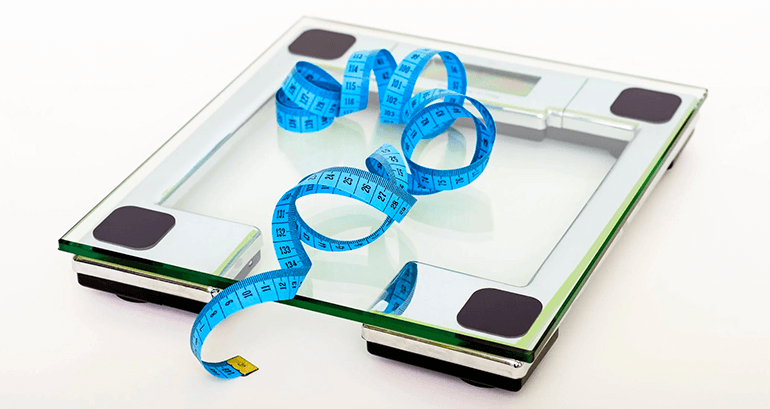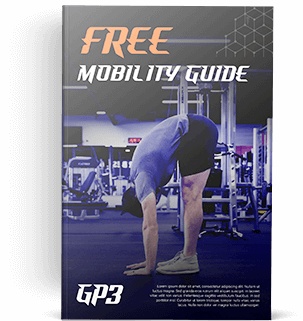Key Points:
1. Your weight does not define you.
2. Most people don’t use the scale in an effective manner.
3. Tracking your weekly average weight via daily weigh-ins is a powerful strategy that also has drawbacks.
Estimated reading time: 5-10 minutes
Listen to this article on Spotify!
In January, we dedicated a great deal of time to addressing nutrition-related goals. So today, we’re going to focus on the most common method people use to gauge their progress. It’s also a topic that divides opinion–the scale.
A couple weeks ago, I referred to the scale as an “unreliable narrator.” What did I mean by that? Well, like my relationship with counting calories, I have mixed feelings about this device.
On one hand, the scale is an important tool for measuring progress and successful maintenance after weight loss. On the other hand, overreliance on it can dramatically skew our perceptions of our health. But that’s not all. In one sense, the information the scale provides is little more than a useless snapshot. In another, it’s the best piece of information we’ve got. Finally, for some individuals, frequent weigh-ins provide excellent accountability and feedback. For others, these weigh-ins can turn into an unhealthy obsession that sucks the joy out of life. Where does that leave us?
The Research is Clear
As I mentioned last week, we in the U.S. have more of a weight maintenance problem than a weight loss problem. Over 90% of people who lose a significant amount of weight will gain it all back (and often more) within one to three years. Many of the rare few who don’t, however, share a common habit. They continue to track their weight, nutrition intake, or both.
Now, I want to make it clear that just like you don’t need to count calories, you don’t need to use the scale if you don’t want to. The article cited above simply says that 75% of people who successfully “keep the weight off” picked that method for tracking their weight. But there are other options. You could choose one or more of the following:
- Seeing how your clothes fit
- Taking regular progress photos
- Using waist, neck, and limb measurements
- Assessing your energy levels
- Measuring your progress in the gym with regards to your:
- Strength
- Endurance
- Mobility
- Any combination of the above
Keep in mind that with these methods, you do trade some of the objectivity and immediacy of the scale. To clarify, you can see a meaningful change on the scale in just two weeks, but progress may be harder to detect when it comes to waist measurements or the fit of clothing. Further, assessing photos and energy levels can be entirely subjective, while the scale is not. That’s why I recommend picking at least two of the above metrics to regularly measure, and combining them with weigh-ins as needed.
Limitations of the scale
Now, let’s be perfectly clear about two things. First, the number on the scale does not define you. At all. It is simply a piece of data.
Second, this number, in isolation, means very little. To illustrate, if I told you that a person weighed 160 pounds, can you tell me if that’s an optimal weight for them? Trick question. It’s impossible to know!
We would need information about their height, biological sex, body fat percentage, age, activity level (and probably their fitness goals and some data only obtainable through blood work) to even have a remote chance of answering this question accurately. So, the weight number, on its own, is basically useless. With that in mind, how do we make it…not useless?
Daily Weigh-Ins
The practice of weighing oneself daily comes with multiple caveats, which we’ll dive into in a moment. But first, here’s what I’ve found to be the best way to utilize the scale in your fitness and nutrition pursuits.
Step 1: Weigh yourself every single day, at the same time in the morning, after going to the bathroom and before eating or drinking anything.
Step 2: Record this number somewhere that’s readily accessible, like a notebook, the Notes App on your phone, or a spreadsheet.
Step 3: Every Sunday, calculate your average weight from the prior week. Do this by adding up each day’s weight number and dividing by seven. Record this number as well.
Step 4: Use your weekly average weight number as a gauge of how you’re progressing.
The Benefits
This method helps us avoid reading too much into normal weight fluctuations. It’s fairly standard for our weight to go up and down between two and five pounds over the course of one day, especially from evening to the next morning. This happens due to shifts in our hydration level, the amount of stored carbohydrates in the body, hormonal changes, and multiple other factors.
For example, I’ll never forget the time I had a ridiculous, albeit planned, cheat day during my fast food fat loss experiment. I gained six and a half pounds overnight. Luckily, you can’t actually gain that much weight in a day. Not even close. It’s not physiologically possible. Lo and behold, because I immediately returned to eating normally, four and a half pounds dropped off the scale by the following morning. Further, within a week of being in a steady caloric deficit, I dropped to a lower weight than I was prior to the epic overindulgence.
This experience perfectly illustrates the issue with weekly weigh-ins…
Our weight is unpredictable and variable
So, if we engage in the typical practice of “Monday Morning Weigh-Ins,” we’re automatically giving ourselves too small a sample size to know if we made any progress. Even worse, let’s say our weigh-in happens to fall on a day where we’re slightly up despite having done most of the “right” things throughout the week. We may falsely conclude that our efforts aren’t working and give up out of frustration.
Or, let’s say we experienced the less common but still possible outcome of a reduced weight after a weekend of indulgences. We may incorrectly think that we have more leeway to deviate from our plan than we actually do.
Daily weigh-ins reduce the risk of these erroneous conclusions by greatly increasing our sample size.
If you’ll recall, I’ve mentioned the following guidelines from the University of South Florida’s Human Performance and Physique Enhancement Lab multiple times in previous pieces.
For prioritizing fat loss, their research has led them to recommend aiming to lose 0.5% of bodyweight per week, and not more than 1%. Tracking our weekly average weight allows us to know whether or not we’re adhering to this standard.
For example, if a 200 pound person’s weekly average went down 1.5 pounds from one week to the next, we can be fairly certain that represents actual weight lost, not just regular fluctuations. This also gives us more confidence as to the type of weight we’re losing. If we stay within 1% of bodyweight dropped per week, we can be reasonably sure that we’ve lost mostly body fat. And this does matter. Not too many people want to lose 10+ pounds of muscle and water, do they?
Daily weigh-ins aren’t without their drawbacks, though.
Your Weight is Just Data
Here’s a catchy couplet for you:
Don’t think of the scale
As pass or fail
One of my favorite people in the fitness industry, Jordan Syatt, recently shared an interesting peek behind the curtain of his nutrition coaching. He said that he stopped celebrating with his clients when the number on their scale went down, because that automatically implied it was “bad” when the number went up.
This is a fantastic point. When trying to lose weight, it’s difficult not to feel disappointed when the number on the scale goes up, and way harder not to feel vindication or excitement when it goes down. In my experience at least.
And yet, our weight really is just data without morality or significance attached to it.
But, if we want so badly to achieve a certain number on the scale, weighing daily can make this harder to remember. And, just like with counting calories, daily weigh-ins can easily turn into an unhealthy obsession.
So, while I do recommend everyone give this strategy a try, (just like counting calories), I also make it clear that we should watch out for the following warning signs. If you:
- Start weighing yourself multiple times per day…
- Feel more than 10 seconds of disappointment if the number goes up…
- Want to just give up if your weekly average weight went up from one week to the next…
It’s probably time to take a break from daily weigh-ins, as the practice has crossed the line into doing more harm than good.
To that end, if we’re scared of the number on that cold, lifeless digital screen, we have two choices. We can face our fear and look at it anyway, or avoid it. Neither is right, and the latter may be more practical in many cases. However, if the practice of daily weigh-in is causing stress, anxiety, guilt, or shame, it’s clearly time to pick a new method for measuring progress.
Look, Nutrition is Complicated and Personal
It’s hard to know what will work for you until you try it. A perfect strategy for you may be a recipe for disaster for someone else. But you won’t know until you attempt multiple methods and objectively and subjectively assess their effectiveness. Does that last bit sound like a paradox?
Well, it is.
So, should you use the scale? I genuinely don’t know. For me, it’s a useful tool; that’s all I can say. But I do also know that most people use it in a random, overemphasized, and unhelpful way, and suffer accordingly. I don’t want that to be you.
With that in mind, give daily weigh-ins and weekly average weight tracking a shot. Or don’t. But do give your chosen tracking methods some deep thought and a fair chance. And above all, remember that your weight doesn’t define you. In fact, nothing does, but that’s a story for another post.
Before you go, I’d love to hear from you! Have you tried tracking your weekly average weight before? How did it work for you? If not, how do you think you’d benefit from this method? Reply to this email and let me know!

